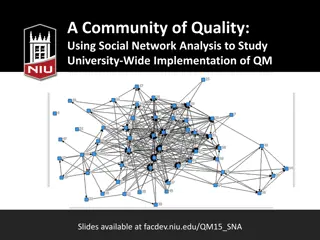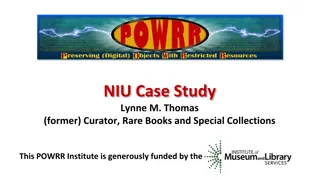
Evolution of Intellectual Control in Digital Archives
Discover the evolution of intellectual control in digital archives, from traditional aggregate control to content-level control enabling detailed information retrieval. Explore the creation of catalogs, finding aids, and guides facilitating researchers in locating relevant materials of interest. Dive into the description of item components, annotation of textual content, and the transition towards item-level control, particularly for digital records.
Download Presentation

Please find below an Image/Link to download the presentation.
The content on the website is provided AS IS for your information and personal use only. It may not be sold, licensed, or shared on other websites without obtaining consent from the author. If you encounter any issues during the download, it is possible that the publisher has removed the file from their server.
You are allowed to download the files provided on this website for personal or commercial use, subject to the condition that they are used lawfully. All files are the property of their respective owners.
The content on the website is provided AS IS for your information and personal use only. It may not be sold, licensed, or shared on other websites without obtaining consent from the author.
E N D
Presentation Transcript
CONTENT-LEVEL INTELLECTUAL CONTROL FOR DIGITAL ARCHIVES Jinfang Niu School of Information University of South Florida
Archival intellectual control the creation of tools such as catalogs, finding aids, or other guides that enable researchers to locate relevant materials relevant to their interests. From Richard Pearce-Moses, A Glossary of Archival and Records Terminology. Creation of catalogs, finding aids and other guides Help researchers locate records Traditionally aggregate control dominate Item-level control is becoming common, especially for digital records
The evolution of intellectual control Today, the intellectual control of digital records reaches below the item level Content-level control Description of item components Annotation of textual content Description of individual entities, variables or survey questions within datasets Content-level control helps discover information from the content of records, instead of discovering records.
Description of item components A multi-page manuscript document (an item) may be digitized as several computer files, each of which is for one page. The scanner may automatically capture some metadata for each page Optical Character Recognition (OCR) software can provide the transcripts for the content of each page. In this case, page level control enables users to locate the particular page where the searched content is from. Example: http://reflections.mndigital.org/cdm/compoundobject/collection/p1 6022coll32/id/197 You can see metadata for each individual page, in addition to metadata for the record level
Annotation of textual content The collection documents Perlman's career as an economist and author at <corpname>University of Pittsburgh</corpname> and reflects his interest in work arbitration, trade unions, and the economics of public health. Among correspondents are many noted economists, including <persname >Martin Shubik </persname>, and <persname>Martin Bronfenbrenner </persname>. While many of the letters are personal in nature, others contain considerable information about Perlman's work, particularly in the years around the publication of his works <title>Judges in Industry: A Study of Labor Arbitration in Australia</title> <date type="publication">(1954)</date>. Additional correspondence relates to the publication of the <title >Journal of Economic Literature</title>. adapted from one example in the EAD tag library. The markup helps users find entities of particular types, more accurate than pure keyword search.
Description of individual entities in datasets Support the discovery of individual entities within datasets Eg. Search for individual passengers based on last name, first name, age, country of origin, destination city/county, and other factors within the data file Russians to America Passenger Data File, 1834 1897 in the Access to Archival Databases (AAD) of NARA.
Description of variables and survey questions within datasets Support the discovery of variables Common in social science data archives Supported by the DDI standard Metadata for individual entities, variables and survey questions are usually not originally created by archivists. However, archivists have the responsibility of checking their accuracy and completeness.
Want to read more about this? Jinfang Niu (2016) Archival Intellectual Control in the Digital Age, Journal of Archival Organization, 12:3-4, 186-197, DOI: 10.1080/15332748.2015.1154747
Thanks! Questions?


